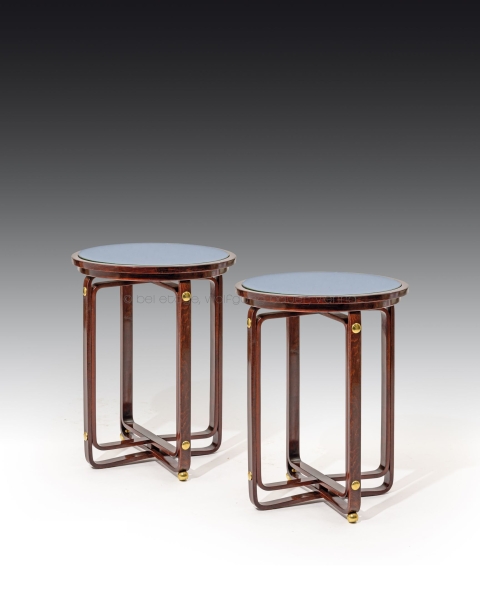KOLOMAN MOSER
| About the artist | 1868 – Vienna – 1918 |
| Designed by | Koloman Moser, Vienna, 1900 |
| Executed by | Portois & Fix, Vienna |
| Marked | on all four locks: Portois & Fix, Wien, 4132 H |
| Dimensions | H 180 cm, W 168 cm, D 67 cm |
| Material | Maple veneer with geometrical inlay "The Rich Catch of Fish" in mahogany and boxwood, brass fittings, excellent original condition, surface slightly cleaned and polished, first-class original condition |
| Provenance | private property, Austria |
| Literature | Ver Sacrum, vol. 3, 1900, ill. p. 379; Acht Jahre Secession, p. 282 ff, p. 287; Die Kunst, 1901, vol. lV, ill. p. 184; DK, 1900, vol. lV, ill. p. 184 (Innendekoration/interior design); 1901, vol. Xll, ill. p. 35; 1902, vol. Xlll, ill. p. 235; The Studio, 1904, vol. XXXIII, ill. p. 114; Himmelheber, ill. 1148; Das Interieur, vol. 4, 1903, ill. pp. 36, 38 |
Until 1900, the exhibitions shown at the Vienna Secession, the first important work of Jugendstil architecture in Vienna designed by Joseph Maria Olbrich, focused mainly on works of fine arts. It was not until the Eighth Secession Exhibition in 1900 that furniture, furnishings and even a complete music room were presented alongside sculptures and decorative art objects. The artists represented at this ground-breaking exhibition included the important Belgian sculptor Georg Minne and several of his Viennese peers, including Georg Wrba. The music room was designed by Charles Rennie Mackintosh, who exhibited together with his wife Margaret McDonald Mackintosh at the invitation of Fritz Waerndorfer and Josef Hoffmann. Breaking with tradition, furniture designed by Josef Hoffman, Leopold Bauer and Koloman Moser was thus also presented. The presentation of their works therefore marked a very courageous and unusual step, since in previous exhibitions, the strict rule of separating fine and applied arts, i.e. “arts and crafts” had consistently been applied. This recognition of furniture designers as well as “their” cabinet makers and craftsmen as artists, also acknowledging the latters’ work, was key to the further development of the Viennese Jugendstil and the Secession style. Some open-minded upper-class Viennese, including Dr. Spitzer and Dr. Hugo Henneberg, highly appreciated this change from historicism towards stylistic renewal, and commissioned Josef Hoffmann with the construction of numerous villas and homes to be furnished and equipped by Koloman Moser. Especially in Vienna’s nineteenth district, on Hohe Warte – which subsequently became the eponym for the important “Hohe Warte” art magazine – Hoffmann designed numerous villas from 1900 onwards.
Three pieces of furniture designed by Koloman Moser that proved ground-breaking for the Secession style, were presented at this Eighth Exhibition. These were the corner cabinet "The Enchanted Princess", a cigar cabinet and the buffet/sideboard "The Rich Catch of Fish". The buffet exhibited at the time was then acquired by the Ministry of Education and donated to the Austrian Museum of Art and Industry (today’s Museum of Applied Arts, MAK).
Conceived by Moser as part of a complete dining room ensemble, this sideboard/buffet was probably executed three times only. In the relevant literature there are records of the buffet in the MAK collection and of a complete dining room designed for a Dr. Z. In this buffet, Moser combined formal strict design, characterised by clear reduced structures, with the reciprocal “The Rich Catch of Fish” pattern (that obviously served as a substantial source of inspiration for Escher). The buffet’s hight of 180 cm further adds to this exquisite object’s elegance. The reduction to simple fronts, “moving” forwards and backwards along the vertical axis, the six high and slender legs, the accentuation of the vertical line emphasised by the four geometric “The Rich Catch of Fish” inlays as well as the archaic-looking square glass panes in the doors are ground-breaking milestones that paved the way for modern early 20th century design.
This buffet is a museum-quality Vienna Secession-style object that lives up to the highest standards.
M05/23










